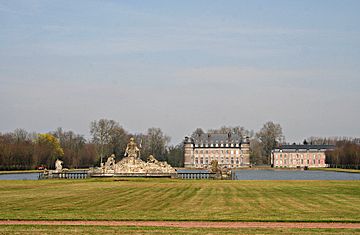Belœil facts for kids
Belœil is a small but interesting municipality in Belgium. It is located in the Hainaut province, which is in the southern part of Belgium. This area is known for its beautiful countryside and historical sites.
In 2007, about 13,446 people lived in Belœil. The town is located at 50° 33 North latitude and 03° 44 East longitude. Belœil is a peaceful place with a rich history, making it a great spot to learn about Belgian heritage.
Contents
What is Belœil?
Belœil is a municipality, which is like a local government area. It includes the main town of Belœil and several smaller villages around it. These villages work together under one local administration.
Where is Belœil located?
Belœil is in the Wallonia region of Belgium. This region is known for speaking French. The Hainaut province is in the west of Wallonia, close to the border with France. Its location makes it easy to visit other parts of Belgium and nearby countries.
What is the history of Belœil?
Belœil has a long history, dating back many centuries. The most famous landmark, the Château de Belœil, has been the home of the House of Ligne family for over 800 years. This family has played an important role in European history. The castle itself has seen many changes and events over the centuries, from medieval times to modern days.
Who are the Princes of Ligne?
The Princes of Ligne are a very old and noble family in Belgium. They have owned the Château de Belœil for a very long time. They are known for their contributions to art, politics, and military history in Europe. The castle is still their private home, but parts of it are open to visitors.
What can you see in Belœil?
The most famous place in Belœil is the magnificent Château de Belœil. It is often called the "Versailles of Belgium" because of its grand design and beautiful gardens.
The Château de Belœil
The Château de Belœil is a large castle surrounded by a moat. It has been rebuilt and expanded many times over the years. Inside, you can find amazing collections of furniture, art, and books. The castle's library alone holds over 20,000 books!
The Gardens of Belœil Castle
The castle's gardens are just as impressive as the building itself. They are designed in the French formal style, with perfectly trimmed hedges, fountains, and statues. There are also beautiful ponds and walking paths. These gardens are a wonderful example of landscape architecture from the 18th century. They are a great place for a peaceful walk.
Other interesting places
Besides the castle, Belœil has charming villages with old churches and traditional houses. You can explore the local markets and enjoy the quiet atmosphere of the Belgian countryside. The area is perfect for cycling and walking.
What is life like in Belœil?
Life in Belœil is generally calm and peaceful. It is a rural area, meaning there are many farms and open spaces. The community is close-knit, and people often know their neighbors.
Local economy
The economy of Belœil is mainly based on agriculture. Farming is an important activity in the region. Tourism, especially related to the castle, also brings visitors and supports local businesses. Small shops and services cater to the needs of the residents.
Education and community
Belœil has local schools for children. Community events and festivals are held throughout the year, bringing people together. These events often celebrate local traditions and history.
Why is Belœil important?
Belœil is important because it preserves a significant part of Belgian history and culture. The Château de Belœil is a national treasure and a major tourist attraction. It helps people understand the lives of noble families and the history of the region.
Cultural heritage
The castle and its gardens are a living museum. They show how people lived in the past and the artistic styles of different eras. This cultural heritage is carefully preserved for future generations to enjoy and learn from.
Tourism
Tourism plays a role in Belœil's importance. Visitors from all over the world come to see the castle and its gardens. This helps the local economy and promotes the beauty of the Hainaut province.
See also
 In Spanish: Beloeil para niños
In Spanish: Beloeil para niños




